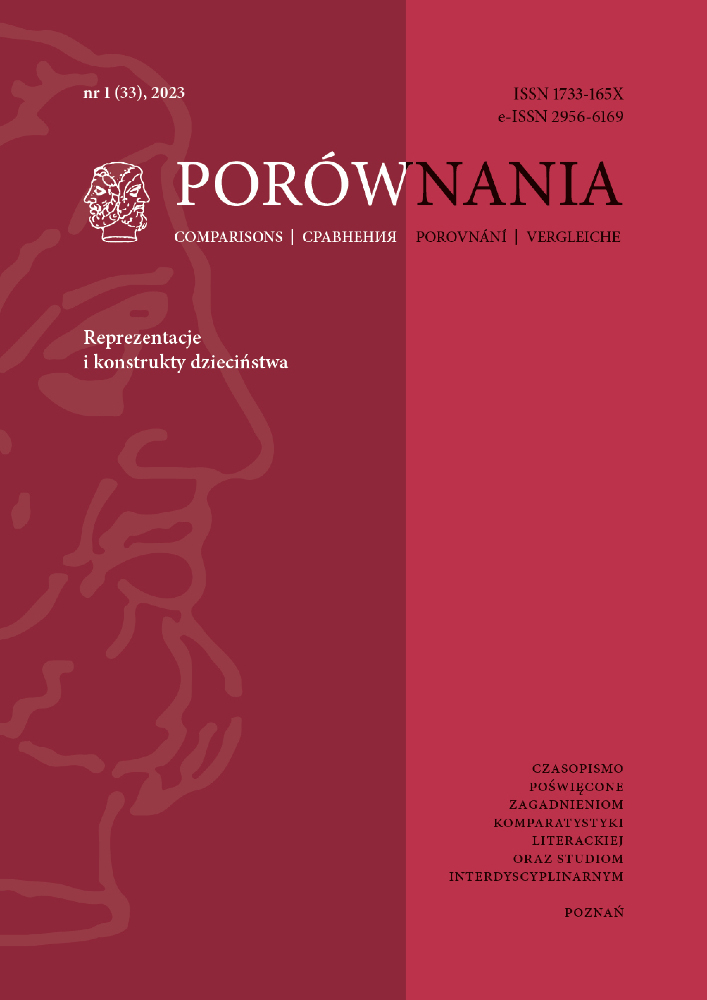Abstract
The aim of the paper is to present four picture books published in Poland that concern the concept of war. These are The Enemy by D. Cali, S. Bloch, War by J.J. Letria and A. Letria, How War Changed Rondo by R. Romanyszyn and A. Łesiw, Bajka o Wojnie (The Fairytale on War) by J. Rudniańska and P. Fąfrowicz. This article examines how the books conceptualise the idea of war in three aspects: emotional, intellectual and historical. The analysis of visual and verbal content proves that the mentioned works affect mostly emotions. Anxiety caused by war seen as a destructive force is the main emotion created on the pages, and a happy ending is the way of excising it. Only one book, War, leaves the reader with this negative emotion. The Enemy, on the other hand, is the only book which contains an intellectual reflection about military conflict: the responsibility for its outbreak and individual commitment towards war. The presence of reflective component in books about war is not dependent on the age of the readers projected by publishers. The historical information is not present enough in the analysed books, but a universal perspective on the subject extenuates it. The main conclusion is that the presented books advocate an anti-war attitude through emotional influence, which, however, does not give the child readers a sense of security.
References
Białek Józef Zbigniew (1978), Ideowe i artystyczne właściwości prozy dla dzieci i młodzieży o tematyce wojennej i okupacyjnej, w: Stanisław Frycie, Literatura dla dzieci i młodzieży w latach 1945–1970. Zarys monograficzny. Materiały – proza, t.1, Wydawnictwa Szkolne i Pedagogiczne, Warszawa.
Cali Davide, Bloch Serge (2014), Wróg, przeł. Katarzyna Skalska, Zakamarki, Poznań.
Fornalczyk-Lipska Anna (2018), Linguistic and Visual Representations of War in Picture Books, „Kwartalnik Neofilologiczny”, LXV, z.1, s. 60–73.
Gdak Beata (2009), Musimy uczyć w szkołach, przedszkolach, na uniwersytetach, że zło jest złem i że miłość jest obowiązkiem. O wojennej literaturze dla dzieci, „Guliwer”, nr 2, s. 5–14.
Güzelyurt Tugçe (2022), An Investigation of the Concept of War and Peace in Illustrated Children’s Books, „Çukurova University. Faculty of Education Journal”, t. 51. DOI: https://doi.org/10.14812/cuefd.1020036
Kąkiel Małgorzata (2015), Wojna i pokój, „Nowe Książki”, nr 7, s. 91.
Kostecka Weronika (2017), Once Upon a Time There Was a War: The Use of Fairy-tale Conventions in Contemporary Polish Literature for Children about Refugees, „Maska”, nr 36, s. 33–49.
Letria José Jorge, Letria André (2021), Wojna, przeł. Katarzyna Okrasko, Dwie Siostry, Warszawa.
Nikolajeva Maria (2013), Picturebooks and emotional literacy, „The Reading Teacher” tom 67, zeszyt 4, s. 249–254. DOI: https://doi.org/10.1002/trtr.1229
Piotrowska Eliza (2018), Patriota w czasach pokoju, „Guliwer”, nr 3, s. 59–63.
Ranke Kurt (1997), Rozważania o istocie i funkcji bajki, przeł. Jan Mirosław Kasjan, „Literatura Ludowa”, nr 2, s. 3–30.
Romanyszyn Romana, Łesiw Andrij (2016), Wojna, która zmieniła Rondo, przeł. Aleksandra Ada Oranż, Wydawnictwo Krytyki Politycznej, Warszawa.
Rudniańska Joanna, Piotr Fąfrowicz (2015), Bajka o Wojnie, Wydawnictwo Bajka, Warszawa.
Sikora Aleksandra (2014), W jaki sposób mówimy dzieciom o wojnie? Charakterystyka prozy o tematyce wojennej na podstawie wybranych książek dla dzieci, „Acta Universitatis Lodziensis. Folia Librorum”, t. 2, s. 25–44.
Sikorska Magdalena (2017), With Frankness on War?, „Studia Paedogogicae Ignatiana”, nr 4 (20), s. 72–81. DOI: https://doi.org/10.12775/SPI.2017.4.004
Wądolny-Tatar Katarzyna (2016), Synekdocha jako trop wizualny w książkowych ilustracjach dla dzieci (na przykładzie wybranych narracji słowa i obrazu o drugiej wojnie światowej), w: Literatura i inne sztuki w przestrzeni edukacyjnej dziecka, red. A. Ungeheuer-Gołąb, U. Kopeć, Wydawnictwo Uniwersytetu Rzeszowskiego, Rzeszów, s. 164–176.
Wądolny-Tatar Katarzyna (2017), Dziecko i wojna w perspektywie postpamięci. Narracje dla najmłodszych, „Litteraria Copernicana”, nr 3 (23), s.111–124. DOI: https://doi.org/10.12775/LC.2017.053
Wojna to imię małej Japonki…, https://bajkizbajki.pl/ksiazki/Bajka-o-Wojnie [dostęp 30.09.2022].
Wójcik-Dudek, Małgorzata (2016), W(y)czytać Zagładę. Praktyki postpamięci w polskiej literaturze XXI wieku dla dzieci i młodzieży, Wydawnictwo Uniwersytetu Śląskiego, Katowice.
License
Copyright (c) 2023 Magdalena Bednarek

This work is licensed under a Creative Commons Attribution-NoDerivatives 4.0 International License.
Utwory opublikowane w czasopiśmie „Porównania”, na platformie Pressto należącej do Uniwersytetu im. Adama Mickiewicza w Poznaniu są udostępniane na licencji Creative Commons Uznanie autorstwa - Bez utworów zależnych 4.0 Międzynarodowe (CC BY-ND 4.0)
Tym samym wszyscy zainteresowani są uprawnieni do korzystania z utworów opublikowanych pod następującymi warunkami:
-
uznania autorstwa — czyli obowiązek podania wraz z rozpowszechnianym utworem informacji o autorstwie, tytule, źródle (odnośniki do oryginalnego utworu, doi) oraz samej licencji
-
bez utworów zależnych — remiksując, przetwarzając lub tworząc na podstawie utworu, nie wolno rozpowszechniać zmodyfikowanych treści.
-
brak dodatkowych ograniczeń — nie można korzystać ze środków prawnych lub technologicznych, które ograniczają innych w korzystaniu z utworu na warunkach określonych w licencji.
Uniwersytet im. Adama Mickiewicza w Poznaniu zachowuje prawo do czasopisma jako całości (układ, forma graficzna, tytuł, projekt okładki, logo itp.).
Autor zachowuje prawa majątkowe, ale udziela zgody Uniwersytetowi im. Adama Mickiewicza w Poznaniu na wykorzystanie dzieła. Autorzy tekstów zakwalifikowanych do publikacji proszeni są o wypełnienie podpisanie i przesłanie umowa (PL) agreement (EN)
Agreement for granting a royalty-free license to works with a commitment to grant a CC sub-license





